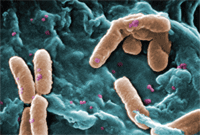The growth of bacterial resistance is evolving faster than the rate at which new antibiotics can be discovered and approved.

Pseudomonas aeruginosa. Image: CDC/Janice Haney Carr.
So, Ching-Hong Yang, Ph.D., a microbiologist at University of Wisconsin–Milwaukee, came up with a different approach: Rather than try to kill the bacteria, why not just cut it off at its knees?
To that end, Dr. Yang and his colleagues have developed a compound that shuts off the process in the bacteria’s DNA that allows it to invade and infect. So the bacteria remain alive, but are no longer virulent. This compound promises to be as effective as an antibiotic but without destroying normal microbial flora or promoting bacterial resistance.
Specifically, it takes aim at the type III secretion system (T3SS), which gives pathogens their ability to invade a cell, letting in a host of proteins that enhance the bacterium’s ability to cause disease. Dr. Yang’s compound blocks the production of T3SS, shutting down the pathogen’s virulence. “The T3SS is an attractive target for development of antimicrobial compounds since it is present mainly in pathogenic gram-negative bacteria and is often required for virulence by these species,” he says.
Although Dr. Yang and his colleagues have tested the compounds on just three pathogens, they expect the compounds will be effective against far more. Among the bacteria they tested: Pseudomonas aeruginosa, which is resistant to a broad range of antibiotics.
It’s not just the imprudent use of oral antibiotics that is causing resistance. Antibiotics are routinely sprayed on crops and are widely used in factory farming of animals, which causes resistance to develop quickly. That antibiotic resistance is then transferred to humans who eat the food containing antibiotic-resistant bacteria.
Dr. Yang and his lab members are now working on developing more derivatives that could be effective against different kinds of harmful bacteria. Although much further research needs to be done, the commercial application of such compounds could be huge.
Yamazaki A, Li J, Zeng Q, et al. Derivatives of plant phenolic compound affect the type III secretion system of Pseudomonas aeruginosa via a GacS/GacA two component signal transduction system. Antimicrob Agents Chemother. 2011 Oct 3. [Epub ahead of print]

